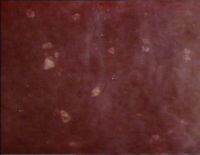Equine Adenovirus
Introduction
Equine Adenovirus is a DNA virus from the Adenoviridae family which is widely distributed in the horse population worldwide.
Most infections are subclinical and it can persist in the upper respiratory tract of adult horses in a carrier state.
The typical isolates are referred to as equine adenovirus type 1 and an equine adenovirus type 2 has been isolated in some cases.
Adenovirus is an important cause of morbidity and mortality, causing necrotising bronchiolitis in Arabian foals suffering from Equine Severe Combined Immune Deficiency, which is characterised by the absence of functional B and T lymphocytes.
The virus is acquired as a droplet or close-contact respiratory or ocular infection. The virus then replicates in epithelial cells throughout the respiratory tract, producing lysis and sloughing of these cells and a hyperplastic response in the remaining cells. Immunocompetent horses recover within 10 days, but mixed infections with other viruses and bacteria may cause more severe and prolonged disease. The virus can also infect cells in the gastrointestinal tract and can be shed in the faeces.
Clinical Signs
In adults, infection can cause: acute upper respiratory disease with nasal discharge and conjunctivitis, bronchopneumonia, GI tract infection leading to loose faeces.
There may also be coughing after exercise and enlarged submandibular lymph nodes.
In foals with immunodeficiency, infection is characterised by: intermittent fever, rhinitis, conjunctivitis, pneumonia and diarrhoea. Foals appear normal at birth, develop clinical signs between 2 and 6 weeks, and die within 2 weeks.
Immunocompetent foals exposed to adenovirus may develop conjunctivitis, dyspnoea, fever, coughing and diarrhoea. It is rarely fatal, but deaths have been documented when several different pathogens have been involved.
Diagnosis
Virus isolation from nasopharyngeal and conjunctival swabs during the acute phase of infection is possible but not frequently reported.
Adenovirus can also be detected in fecal samples by electron microscopy.
Seroconversion can be detected by serum neutralisation of haemagglutination inhibition (HI) of paired samples collected 10-14 days apart.
In Arab foals, diagnosis is usually made at necropsy:
Gross findings include: necrotizing bronchiolitis, interstitial pneumonia, fibrin and hyalin membranes within the alveoli. There is atelectasis and consolidation of lobules in cranioventral region. A mucopurulent exudate can be found in the airways. The lymph nodes, spleen and thymus are small with virtually no germinal centres. Foci of abscess formation due to bacterial infection are frequently present.
Histologically: Bronchiolar obstruction by sloughed debris is evident. Large basophilic intranuclear inclusion bodies occur in respiratory epithelial cells and sometimes in the epithelial cells of the salivary glands and ducts, the conjunctiva, the pancreas, the bladder and the small intestine.
Adenovirus can usually be isolated from lung tissue. Primary equine kidney cells are the cell line of choice for virus isolation.
Treatment
No treatment recommendations exist for foals with [[SCID. The prognosis is grave and foals usually die within 2 weeks of infection.
Adult horses rarely show significant disease, but supportive care such as antibiotic cover to prevent secondary infections, mucolytics and anti-inflammatories can be given if necessary. Horses usually recover within 10 days.
References
Snyder, J. (2006) The Equine Manual Elsevier Health Sciences
Sellon, D. (2007) Equine Infectious Diseases Elsevier Health Sciences
Mair, T. (1998) Equine medicine, surgery and reproduction Elsevier Health Sciences
Robinson, N. (2009) Current therapy in equine medicine Elsevier Health Sciences
| This article has been peer reviewed but is awaiting expert review. If you would like to help with this, please see more information about expert reviewing. |
Error in widget FBRecommend: unable to write file /var/www/wikivet.net/extensions/Widgets/compiled_templates/wrt69511b1d6d6000_01708301 Error in widget google+: unable to write file /var/www/wikivet.net/extensions/Widgets/compiled_templates/wrt69511b1d7a9b98_53391678 Error in widget TwitterTweet: unable to write file /var/www/wikivet.net/extensions/Widgets/compiled_templates/wrt69511b1d833882_62416213
|
| WikiVet® Introduction - Help WikiVet - Report a Problem |
